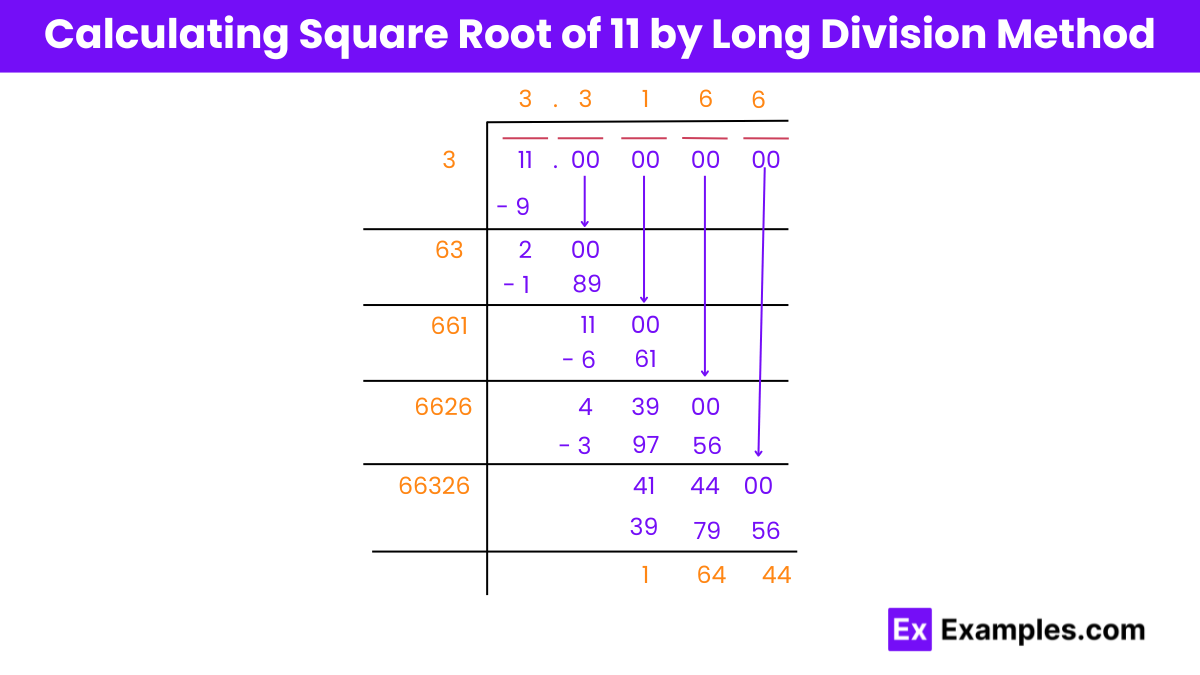What is the square of 11?
111
120
121
131

To calculate the square of 11, you simply multiply 11 by itself:
Therefore, the square of 11 is 121. This straightforward calculation is a building block for more complex mathematical operations and concepts, including algebraic equations, geometric formulas, and statistical models.
Or
√11 = 3.316 up to three places of decimal.
The square root of √11, represented as 1111, is an irrational number, which means it can’t be accurately expressed as a fraction. The approximate value is 3.3166, positioning it between 3 and 4 on the number line. Being the square root of a non-perfect square, it does not resolve into a neat, whole number, embodying its irrational characteristic. This nature makes it an intriguing figure in both mathematical theory and practical computations.
Exponential Form of 11: (11)½ or or (11)0.5
Radical Form of 11: √11
The square root of √11 is an irrational number.
When we delve into the nature of the square root of 11, we confront a fascinating aspect of numbers: the divide between rational and irrational numbers. To understand this distinction and determine the category of the square root of 11, let’s explore the definitions and characteristics of these two types of numbers.
Rational Numbers: These are numbers that can be expressed as the quotient or fraction qp of two integers, where p and q are integers and q is not zero. Examples include 1221, 4334, and −52−25. Rational numbers can also be represented as terminating or repeating decimals.
Irrational Numbers: In contrast, irrational numbers cannot be expressed as fractions or ratios of integers. They are non-repeating, non-terminating decimals without a predictable pattern. Famous examples include π, e, and the square root of 2 (22).
Now, let’s apply this knowledge to the square root of √11 (1111). To ascertain whether it is rational or irrational, we must determine if it can be represented as a fraction of two integers. Through mathematical proofs and properties, it is established that the square root of any non-perfect square (a number that is not an integer’s square like 1, 4, 9, 16, and so on) is always irrational. Since 11 is not a perfect square, its square root cannot be expressed as a simple fraction of integers.
Finding the value of mathematical expressions like the square root of a number involves various methods and techniques. Here are several approaches to finding the value of the square root of √11:
By employing these methods, you can find the value of the square root of 11 with varying degrees of accuracy and complexity. Depending on your needs and the tools available, you can choose the method that best suits your requirements.

Finding the square root of √11 using the long division method involves a step-by-step process of approximation. Here’s how it’s done:
So, the square root of 11, using the long division method, is approximately 3.31662479.
Yes, 11 is not a perfect square. A perfect square is a number that can be expressed as the product of an integer multiplied by itself. For example, 4 (2 * 2) and 9 (3 * 3) are perfect squares because they can be expressed as the square of an integer. However, 11 cannot be expressed as the product of an integer multiplied by itself, so it is not a perfect square. The square root of 11 is an irrational number, approximately equal to 3.31662479.
A: The quickest method to square a number is to multiply it by itself. For instance, to find the square of 5, you would calculate 5×5=255×5=25.
A: No, the square root of 11 is not a perfect square. A perfect square is the product of an integer multiplied by itself, and 11 does not meet this criterion.
A: Yes, the square root of 11 is a real number. It is an irrational number that cannot be precisely expressed as a fraction or decimal, but it exists on the real number line.
A: The number 3 is closest to the square root of 11. This is because 1111 is approximately 3.3166, making 3 the nearest whole number.
A: No, the square root of 11 is not a prime number. Prime numbers are defined as whole numbers greater than 1 that have only two distinct positive divisors: 1 and themselves. The square root of 11, being an irrational number, does not meet these criteria.
In conclusion, squaring 11 yields 121, a straightforward process where 11 is multiplied by itself. On the other hand, the square root of 11, symbolized as 1111, is classified as an irrational number, indicating it cannot be precisely represented as a fraction or a finite or repeating decimal. It is situated between the integers 3 and 4 on the numerical continuum.
Text prompt
Add Tone
10 Examples of Public speaking
20 Examples of Gas lighting
What is the square of 11?
111
120
121
131
Which of the following is closest to the square root of 11?
3.1
3.2
3.3
3.4
If x² = 11, what is x?
3.1
3.2
3.3
3.4
Simplify √11 to its decimal form.
3.314
3.316
3.317
3.318
What is (11)²?
110
111
120
121
Find the approximate value of √11 to two decimal places.
3.31
3.32
3.33
3.34
Which number is not a square of an integer but closest to 11?
9
10
11
12
What is the value of 11 raised to the power of 0.5?
3.31
3.32
3.33
3.34
Calculate 11 × 11.
110
111
120
121
What is the approximate value of √11 between which two integers?
3 and 4
2 and 3
4 and 5
5 and 6
Before you leave, take our quick quiz to enhance your learning!

